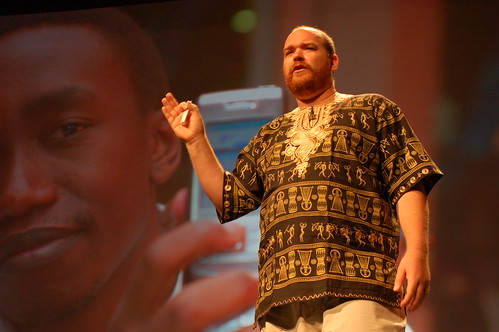Home + Housewares Show 2009...in Cartoons!
/

(via Twine)

(via Twine)
 A century of most popular baby names - top 50 by decade
A century of most popular baby names - top 50 by decade
Yesterday's post commented on Fast Company's recognition of the importance of visualization skills. In their commentary, FC posted screenshots and video of word-images created with Wordle.
These Rorchschach-like wordmaps are fun, easy and effective to create with this (free) java-based web service. Many websites (including ours) now use the resulting images as navigation, sitemaps or splash screens. The Wordles give the viewer an instant impression of themes and importance ideas through font size and color.
I was blown away to see a Wordle used on the front page of USA Today as a feature article--not on the tool or on data visualization, but used as a graphic to illustrate the shifting trend in baby names!
 The Tokyo firm Information Architects created this Web Trend Map which presents the most popular Internet sites in the intelligible graphic language of a subway system.
The Tokyo firm Information Architects created this Web Trend Map which presents the most popular Internet sites in the intelligible graphic language of a subway system.
It is great to see that Fast Company is catching the visualization religion.
This post mentions the Obama speech Wordles, Tufte's screed against PowerPoint, and blogs that cover visual complexity (including the blog, Visual Complexity.
Visualization may play a big role in wising up consumers. In the future, we're told, sensors will pick up tiny bits of info on every aspect of our lives and they will be played back to us as graphics. The smart grid, for example, will read the energy use in your home and send back understandable displays suggesting how you might save money by, say, waiting an hour to turn on your air conditioner or reducing your thermostat by two degrees. It will be up to architects to imbed this feature in the home in a way that allows us to interact more efficiently with our surroundings.
It's good to know, however, that Alphachimp Studio is on the frontier of design!
Check out more Obama visualizations not mentioned by Fast Company (bastages) at The Center for Graphic Facilitation:
 A Sliver of the On-line Collaboration Ecosystem
A Sliver of the On-line Collaboration Ecosystem
With travel budgets slashed, fuel prices on the rise again, airport horror stories, summer storms,... who wants to travel for a meeting?
Along with Joe Sterling, we at Alphachimp have been developing Remote Graphic Capture to enable graphic recording via on-line collaborative tools. This article compares 17 best-in-class tools for virtual meetings.
Online conferencing tools are used for many reasons – sales presentations, webinars and training, to name a few. Plus, if you work from home, like many freelancers and small business owners do, you face the unique challenge of needing live meeting time with clients who may be located around the world.
There are many online meeting tools out there that offer a variety of features at varying costs. Here are a few tools you may want to consider, some of their notable features and the cost for using them.
Let us know what you have found useful in dodging the airport blues while experiencing quality collaboration with peers. Or (shameless plug) schedule a demo of RGC today!
by Susan Pinker from Globe and Mail on why physical distance still matters in the age of the internet.
(via Twitter @valdiskrebs @barrywellman)| May 20, 2009
From the May 2009 Scientific American Magazine: Comparisons of the genomes of humans and chimpanzees are revealing those rare stretches of DNA that are ours alone
The 1 percent difference: Humans are distinct from chimpanzees in a number of important respects, despite sharing nearly 99 percent of their DNA. New analyses are revealing which parts of the genome set our species apart. continue reading
Also check out:
From Allison Arieff's blog By Design at New York Times on-line (thanks to @lumpysnake!):
Every worker would appreciate Steven M. Johnson's Nod Office (1984), an ingenious desk that can be transformed into a hidden sleeping chamber, perfect for late afternoon naps. Owning such a contraption remains for me a significant yet unrealized career goal.

Johnson is the author of an illustrated 1984 book: “What the World Needs Now: A Resource Book for Daydreamers, Frustrated Inventors, Cranks, Efficiency Experts, Utopians, Gadgeteers, Tinkerers, and Just About Everybody Else.”
Amen, brother!
See more brilliantly perverse inventions posted in Allison's article: Searching for Value in Ludicrous Ideas
 IMAGE from Frank Warren's Post Secret
IMAGE from Frank Warren's Post SecretFrom The Marcus Buckingham Company:
In today’s unpredictable environment, comments managers make or actions they take, even simple decisions, can create uncertainty among their employees. Uncertainty creates fear, skepticism and anxiety. An employee who is operating with any of these emotions in play is unlikely to be offering up his or her best.
Here are 7 keys to help you slow the rumor mill and keep employees engaged:
 October 25, 2008: Laurie Garrett shares her proposal for a change in global health policy, and accompanying shifts in foreign policy and perception by countries like the US. photography by kris krüg Renowned global health expert Laurie Garrett gave a powerful and frightening talk at PopTech 2008 on how countries deal - both effectively and ineffectively - with pandemics. Examining China's response to SARS, she asked: what if this happened here? How would we respond? Her presentation is essential viewing right now:
October 25, 2008: Laurie Garrett shares her proposal for a change in global health policy, and accompanying shifts in foreign policy and perception by countries like the US. photography by kris krüg Renowned global health expert Laurie Garrett gave a powerful and frightening talk at PopTech 2008 on how countries deal - both effectively and ineffectively - with pandemics. Examining China's response to SARS, she asked: what if this happened here? How would we respond? Her presentation is essential viewing right now:
http://www.poptech.org/popcasts/popcasts.aspx?lang=&viewcastid=227
Yesterday, just in time for the World Health Organization to raise the threat level from a 3 to a 4 (on a 6-point scale), Laurie gave a wide-ranging press teleconference on Swine Flu. We've summarized some of her high-level questions and answers on our blog:
http://www.poptech.org/blog/index.php/archives/3356

Finally, 2008 PopTech Fellow Erik Hersman (http://twitter.com/whiteafrican) wrote a terrific piece on information patterns that emerge during an emergency on social networking platforms (like Twitter), and how these can be aggregated and turned into real-time maps that shape a strategy for intervention:
http://blog.ushahidi.com/index.php/2009/04/27/information-patterns-and-thoughts-on-swine-flu/
The above represent just the kind of clear thinking we may yet need in this circumstance. Have a look, and if you feel moved to do so, please help us share these insights by forwarding, blogging, and tweeting the above to friends and colleagues.
 It’s been three years since our last pandemic readiness workbook update: Preparing for Pandemic – Family and Neighborhood Readiness Workbook. The Avian Flu has continued to smolder in Asia, Africa and parts of the Middle East only a few new human cases emerged. However, other strains of influenza have continued to mutate, including the new Swine Flu which is in the news today.
It’s been three years since our last pandemic readiness workbook update: Preparing for Pandemic – Family and Neighborhood Readiness Workbook. The Avian Flu has continued to smolder in Asia, Africa and parts of the Middle East only a few new human cases emerged. However, other strains of influenza have continued to mutate, including the new Swine Flu which is in the news today.
You can download a complimentary copy of our updated readiness workbook from our website: http://www.sterlinginsights.com/articles/pandemic_flu_20090501_dnld.pdf
Or you can order a paperback version: http://www.lulu.com/content/263485
From Joe Sterling:
http://www.wpxi.com/video/19313969/index.html
Here’s a great flu explanation on video by Henry Niman, Ph.D. founder of Recombinomics, a research firm focused on genetic evolution of infectious diseases. http://www.recombinomics.com/whats_new.html
I’ve been tracking Niman since 2005 and he is always a bit ahead of everyone else and tells it like it is.
Joe
Alphachimp LLC is a visual learning company based in Houston, Texas.
Through drawings, animations, and the design-thinking process we help people understand complex situations and make better decisions.
We provide a cluster of inter-related services in the area of visual learning, graphic facilitation, problem-solving, and innovation.
COPYRIGHT © 2022 ALPHACHIMP, LLC
ALPHACHIMP® and ROCKSTAR SCRIBE® and DOODLES IN MOTION® are registered in the U.S. Patent and Trademark Office.